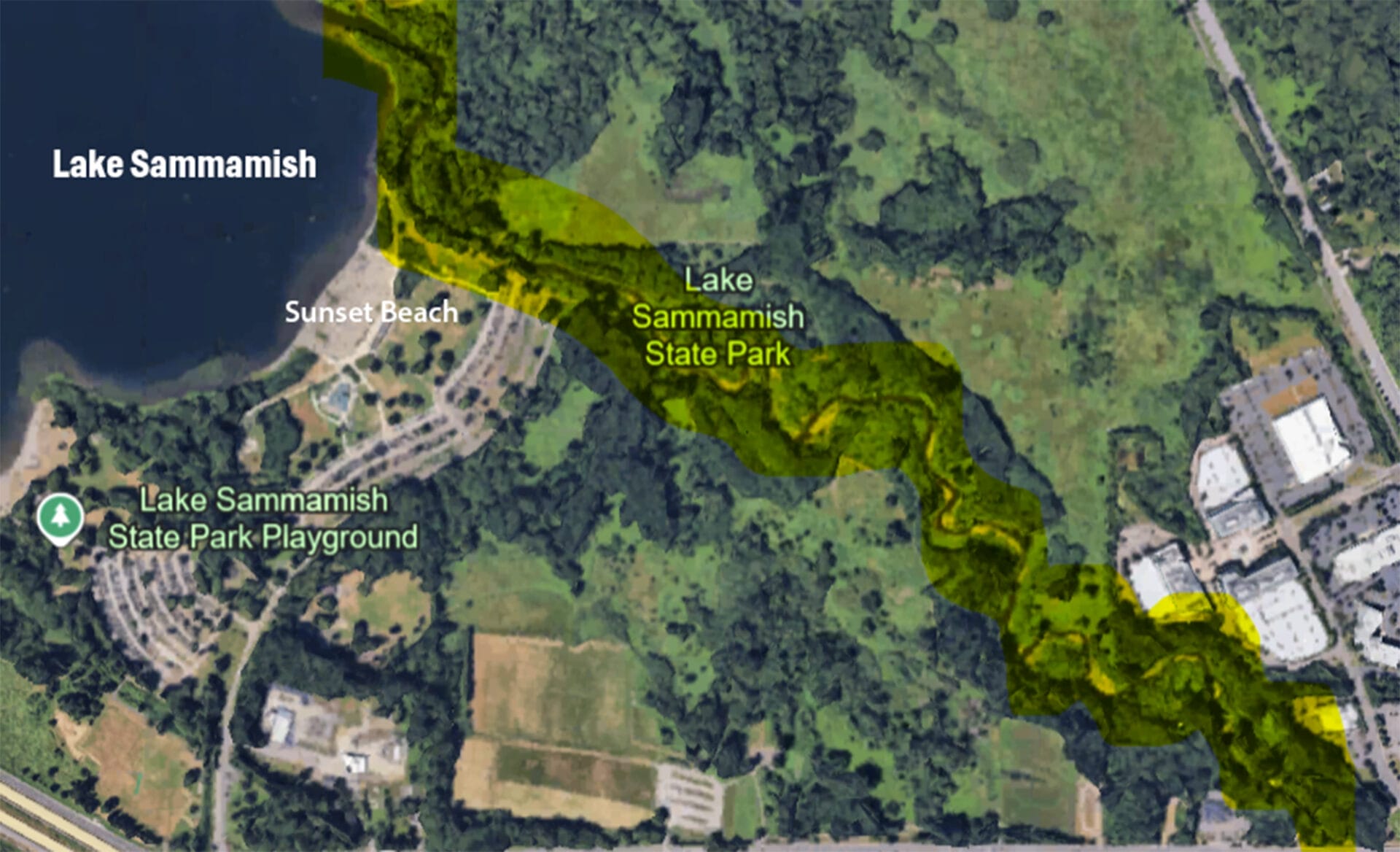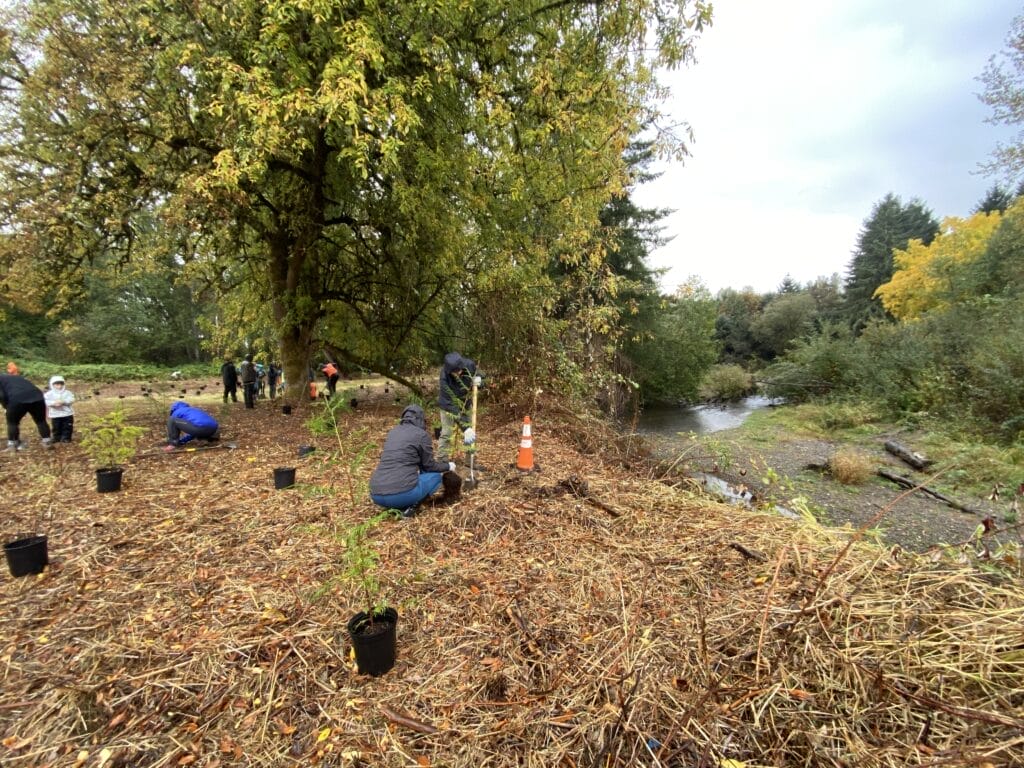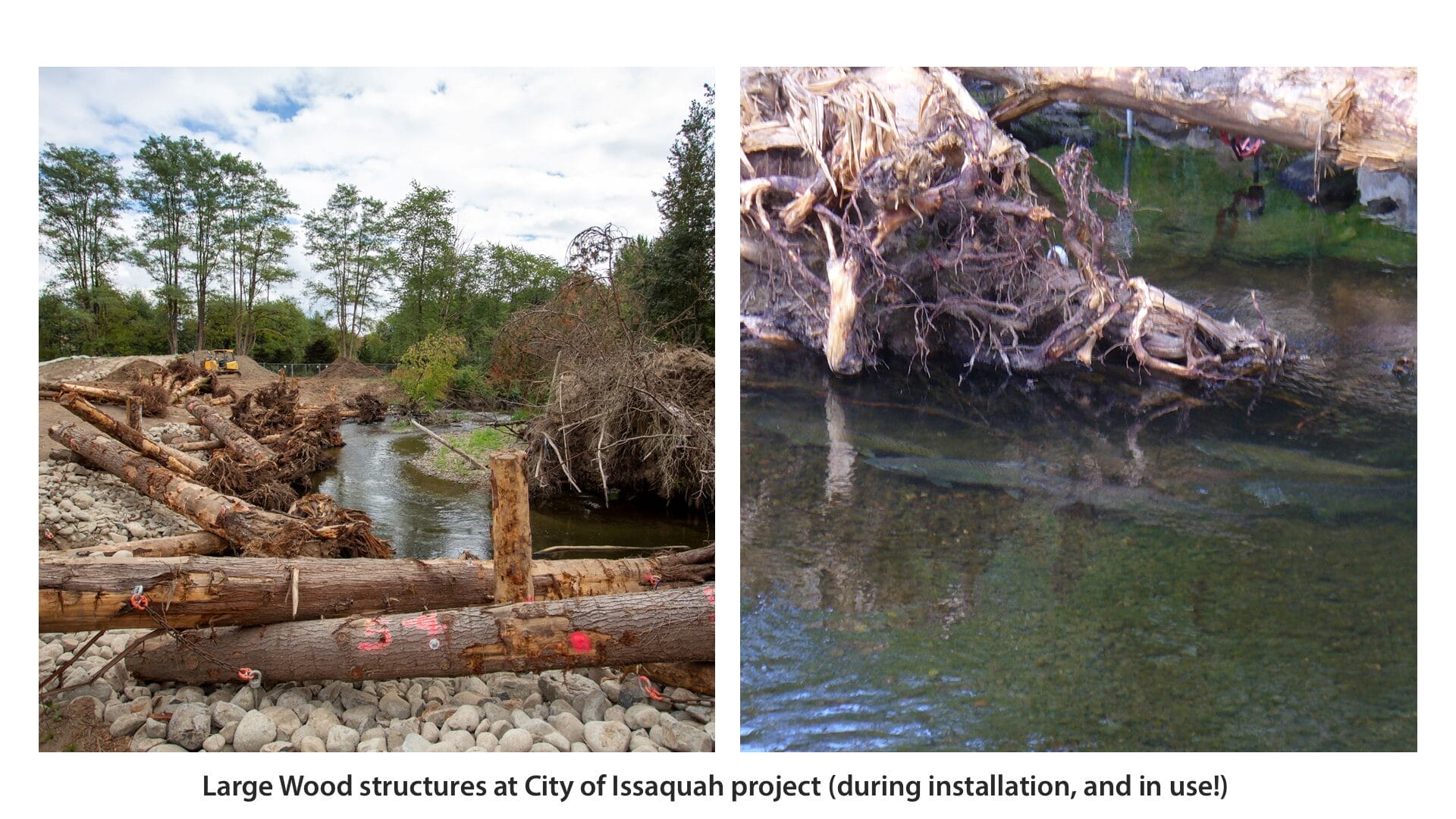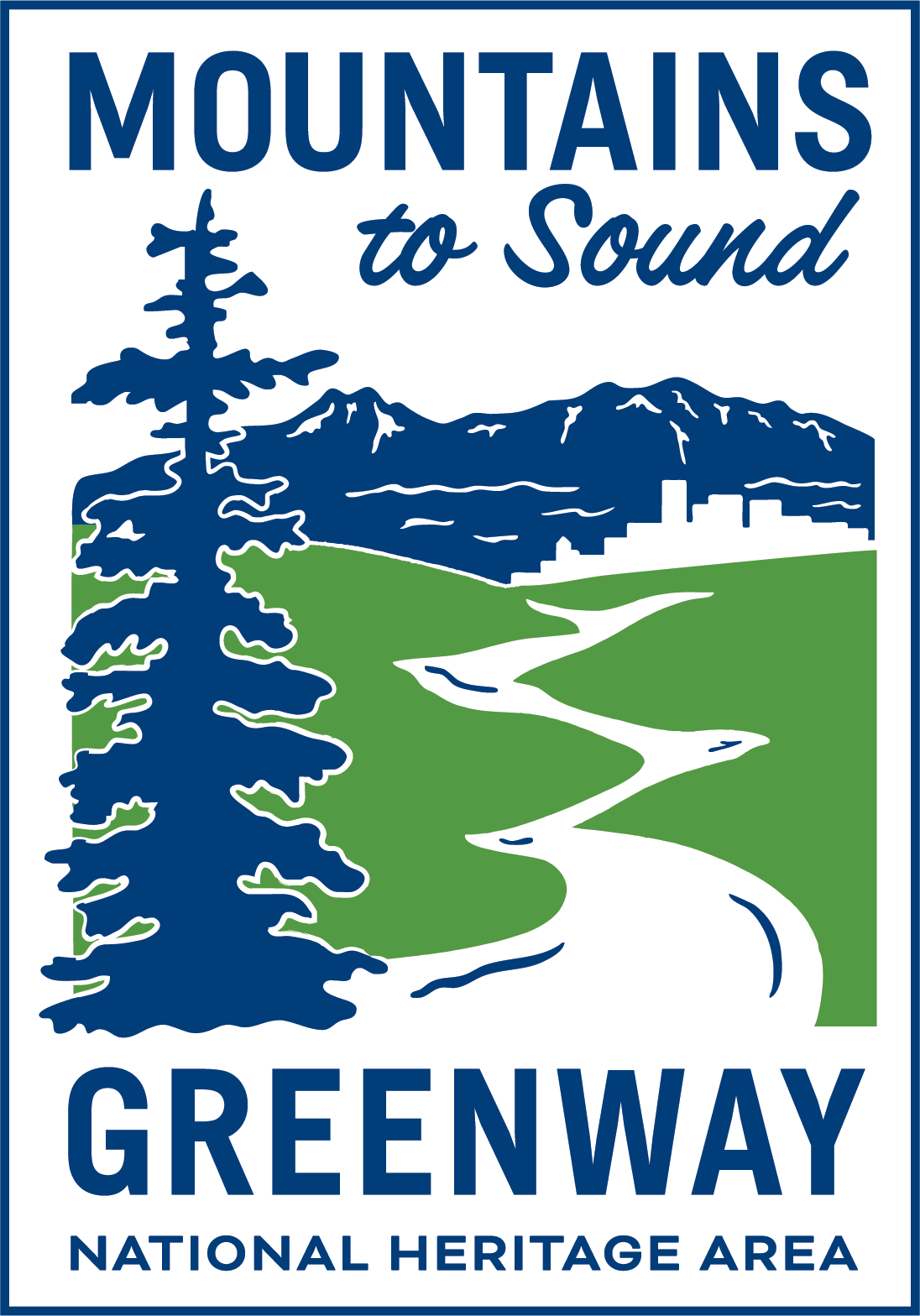A Major Upgrade for Salmon Habitat is Underway in Lake Sammamish State Park!
The Mountains to Sound Greenway Trust recently completed its biggest restoration project yet, and one of the largest in Lake Sammamish State Park’s history: in-stream restoration within Lower Issaquah Creek. We’ve been working with numerous partners and thousands of volunteers for more than two decades to improve this important important salmon habitat. We’ve reached a major milestone, but there’s still more to do!

Volunteers Needed!
We are recruiting volunteers to support tree planting for this project, as well as other trail work and habitat restoration events across the Greenway! Learn more and sign up to volunteer below.
Project Highlights
Location:
Issaquah Creek within Lake Sammamish State Park, from just upstream of the bridge at Sunset Beach to the Park’s upstream border

Timeline:
Spring 2025 | Site visits and project setup
June 15 – August 15, 2025 | In-stream restoration work (approved window to work in stream while minimizing impacts to fish)
Fall 2025 | In-stream work completed and transition to weed removal and tree planting with continued monitoring, maintenance, and planting happening over the course of the next decade
Scope:
- 4,600 feet of in-stream and riparian (streamside) restoration
- 0.3 miles of new side channels
opened by reactivating an old oxbow - 500+ pieces of large woody material added to the stream plus an additional 300+ on top of bank to increase habitat complexity out of water as well
- 10,000-15,000 native trees and shrubs planted within year one


Why Issaquah Creek Needs Help

Since time immemorial, Issaquah Creek has supported salmon, wildlife, and people. However, decades of farming, logging, and development have caused big changes in the creek – making it straighter than it should be, removing natural logjams, and cutting off its floodplains. These changes have disrupted water flow, reduced habitat quality and complexity, and severely hurt Chinook salmon populations, which are now listed as threatened under the Endangered Species Act.
With a salmon hatchery just upstream, literally millions of juvenile salmon utilize this stretch of creek at multiple stages of their life cycle. After hatching, young fish need slow-moving water with shelter to grow, rest, and hide from predators. These safe rearing areas are less common now in Issaquah Creek, making it harder for salmon to survive. This project will help the creek get back to its natural processes, giving young salmon a better chance to survive their journey along the creek and through Lake Sammamish, Lake Washington, and the Ballard Locks.
Climate change is making this work even more important. Rising temperatures, lower summer water levels, and increased winter flooding make life more challenging for salmon. By restoring floodplains, adding large wood, and planting native trees, we’re creating a healthier creek – not just for salmon, but for people and other wildlife too.
Issaquah Creek is like a house with only hallways—no places to rest or eat. This project will help rebuild a real home for them!
Project Background: A Community Effort to Restore Issaquah Creek
Issaquah Creek runs through parks and protected lands today, but it wasn’t always this way. In the 1800s and 1900s, much of the creek was privately owned, leading to major forest habitat loss. By the 1990s, the damage was clear—seasonal flooding of downtown Issaquah, fewer salmon, and reduced creek access for both wildlife and residents.
In response, local leaders created a shared plan to help salmon recover, forming the Lake Washington/Cedar/Sammamish Watershed (WRIA 8) Salmon Recovery Council in 1998. Since then, the Greenway Trust, along with city officials, Tribes, businesses, and volunteers, have worked together to restore this vital ecosystem.
A key first step was securing public ownership of important creekside lands, followed by large-scale habitat restoration. Healthy streams need cool, clean water, stable banks, and places for fish to rest and spawn. Native trees and shrubs help by shading the water, stabilizing the banks, and filtering pollutants before they reach the creek. Without a healthy forest, Issaquah Creek struggles to support salmon.
Over the past 20 years, the Greenway Trust and partners have:
- Removed introduced species like blackberry and ivy, which crowd out native plants
- Planted 50,000+ native trees and shrubs to rebuild a healthy forest along the creek
- Engaged nearly 20,000 volunteers, who have contributed over 70,000 hours to restoration in the park

These actions have transformed much of the creek’s surrounding habitat, improving water quality and creating better conditions for fish and other wildlife. But for salmon to thrive, we must also restore the creek itself.
Taking the Next Big Step: In-Stream Restoration

Starting in spring 2025, we began work on in-stream restoration to give juvenile Chinook and other salmonid species better places to spawn, grow, and survive. By restoring natural river processes, this project will allow Issaquah Creek to heal itself over time, ensuring healthier waters for fish, wildlife, and future generations.
How We’re Improving In-Stream Creek Conditions:
- Reconnected the creek to its floodplain to improve water quality and provide habitat where juvenile salmon can take refuge and rest, no matter how high the creek is flowing.
- Added 500+ pieces of large wood into the creek to create deeper pools with protective cover and slow-moving areas where salmon can rest.
- Placed an additional 300+ pieces of large wood on top of bank to increase habitat complexity out of water
- Reopened historic side channels, providing more space for fish to rest and grow, and redirected water into side channels to help shape and deepen the creek.
- Planting 10,000-15,000 native trees and shrubs within year one that will support wildlife and provide shade to keep the water cool.
- Providing more habitat complexity at various water levels and throughout the year


This project marks completion of nearly all planned restoration in lower Issaquah Creek under the 2005 and 2017 Chinook Salmon Conservation Plans. It also builds on 40+ years of restoration work by the City of Issaquah, including projects at Confluence Park, Salmon Run, Squak Valley Park, and previous in-stream restoration efforts that provided valuable insights for this project.
Get Involved!
Restoration is a long-term investment in our environment, salmon recovery, and future generations. Be part of the effort!

Volunteer
Help care for native plants at our nursery in Lake Sammamish State Park, remove non-native weeds, or join future tree planting events. Click to learn more and sign up!

Support
Raise awareness by sharing this project with your community and speaking up for work that protects salmon and watershed health. You can also support future habitat restoration and maintenance by making a donation to our nonprofit organization.
Project Support
Thank you to the following groups for their role in making this project possible!
Project Team:
- Mountains to Sound Greenway Trust
- Washington State Parks & Recreation Commission
- Northwest Hydraulic Consultants
- Natural Waters, LLC
- Facet
- BCI Contracting, Inc
Contributors:
- Washington State Parks and Recreation Commission (Landowner and Partner)
- Washington State Recreation and Conservation Office and Salmon Recovery Funding Board
- Muckleshoot Indian Tribe & Muckleshoot Indian Tribe Fisheries Department Staff
- Snoqualmie Tribe & Environmental & Natural Resources Department Staff
- Tulalip Tribes & Environmental Division Staff
- Confederated Tribes and Bands of the Yakama Nation & Yakama Nation Fisheries Department Staff
- Congresswoman Kim Schrier (WA-08)
- City of Issaquah
- Washington Department of Fish and Wildlife
- Washington State Salmon Recovery Funding Board and Washington State Recreation & Conservation Office
- King County Flood Control District
- King County Kokanee Work Group
- King County Water and Land Resources Division
- Lake Washington/Cedar/Sammamish Watershed (WRIA 8) and WRIA 8 Technical Committee
- Friends of Lake Sammamish State Park
- Trout Unlimited
- The Boeing Company
- Carter Subaru and Carter Motors
Funding: *
This project is funded in part by the Lake Washington/Cedar/Sammamish Watershed (WRIA 8) and the King County Flood Control District Cooperative Watershed Management Grant Program, the King County Flood Control District’s Flood Reduction Fund, the Washington State Salmon Recovery Funding Board (SRFB) via WRIA 8 and the Washington State Recreation and Conservation Office, the National Fish and Wildlife Foundation, the United States Environmental Protection Agency with support from Congresswoman Kim Schrier (WA-08), and contributions from The Boeing Company.
* Recent funding cuts, freezes, and delayed payments on federally funded grants and agreements have created uncertainty that may lead to scope or timeline adjustments to this project. The team will be assessing these impacts regularly and making decisions to maximize project outcomes with the resources available.
Learn More
Project Coverage in the Seattle Times
Issaquah Creek Restoration Final Design Report
StoryMap: Ecological and Cultural Significance of Salmon in the Greenway NHA

